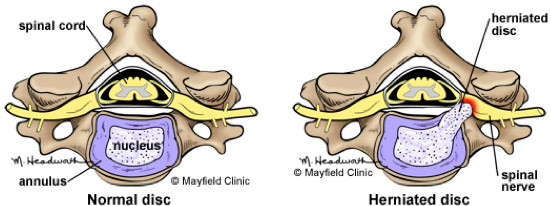by Alan Jordan
As discussed in earlier articles much of what we know about Modic changes relates to patients suffering with lower back pain. The bacteria have been identified and long term antibiotic treatment has been shown to be highly effective in treating this subset of patients.
Modic changes (bone oedema) have been identified on MRI scans for many years, however, their association to back pain and more importantly, how they develop, is relatively new knowledge.
It has been shown that Modic changes come about following disc herniation and/or disc degeneration in the lower back. Modic changes are rather common in patients suffering with chronic (long term) back pain and in secondary spine centres the prevalence of Modic changes is approximately 35%. The percentage of patients seeking care – once again in spine centres – for chronic neck pain that demonstrate Modic changes is less – approximately 8-10%.
Why are there fewer Modic changes in the neck?
As previously mentioned above and more thoroughly reviewed in other articles in this journal the bacteria responsible for causing Modic changes enter the discs following a disc herniation, i.e., the outer fibres of the disc burst allowing the bacteria to enter the disc itself.

The illustrations above demonstrate both a normal and a herniated cervical (neck) disc. As is the case in lower back patients bacteria can enter the disc while the body is attempting to repair the disc by creating new blood vessels in its attempt to heal the damaged outer fibres. This allows bacteria to enter an anaerobic environment in which particular bacteria that cannot tolerate oxygen can thrive. These bacteria then secrete fluids that can erode the bone of the vertebrae above and below the disc resulting in micro-fractures and inflammation. Long term studies have though demonstrated that Modic changes in neck pain patients are closely associated with disc herniations and degeneration in the neck.
One can reasonably assume that this process is identical in both the lower back as well as the neck. However, there are far fewer disc herniations in the neck than in the lower back. There are many possible explanations for this, the most commonly accepted being that the ligaments that support the disc are far stronger and thicker in the cervical spine (neck) than in the lower back region.
Should Modic changes in the Neck also be treated with Antibiotics?
To date, no published studies have investigated this issue. We know that long term antibiotic treatment of lower back pain patients is extremely effective but can only presume that this would be the case in patients with Modic changes in the cervical spine. One can reasonably expect that there are already studies underway in this area due to the fact that antibiotic treatment of chronic lower back pain due to Modic changes is widely regarded as the most important development in the diagnosis and treatment of chronic lower back pain in decades. We anxiously await the results, but expect that they will indeed be similar.
Dr Alan Jordan, Chiropractor, Phd
Board Member, MAST Medical Academy




